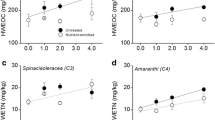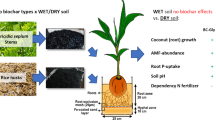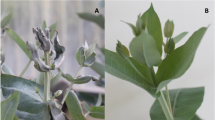Abstract
The effect of macadamia nut shell biochar on nitrogen, potassium, phosphorus, magnesium, calcium and sodium concentrations in potting mix used to grow Eucalyptus nitens seedlings was investigated in a glasshouse experiment. The treatments combined two fertiliser rates (50 and 100% rate of the commercial mix commonly used in forestry nurseries) with eight biochar rates (0, 2, 5, 10, 20, 50, 80 and 100 t ha−1) arranged in a randomised complete block with three replicates of four sample plants. Nutrients were quantified in the potting mix and seedling leaves at four destructive harvests 135, 177, 219 and 269 days after planting. Biochar significantly increased nitrate-N, Colwell P, Colwell K and exchangeable Na and reduced ammonium-N, Mg and Ca concentrations in the potting mix. Seedling leaf concentrations of P, K and Na were increased by biochar application, while N remained dependent on fertiliser rate only. Mg and Ca leaf concentrations decreased in response to increasing biochar rates. Elevated nitrate-N and decreased ammonium-N concentrations suggest that biochar might have increased nitrification in the potting mix. We presumed that biochar mediated processes that reduced uptake of P and K when high doses of biochar were combined with full fertilisation. Changes in potting mix K, Na, Mg and Ca were consistent with selective adsorption of ions to biochar surfaces.











Similar content being viewed by others
References
Bear FE (1965) Soils in relation to crop growth. Agricultural College and Experiment Station, Rutgers—the State University, New Brunswick, NJ, USA: Reinhold Publishing Corporation
Chan KY, Xu Z (2009) Biochar: Nutrient properties and their enhancement. In: Lehmann J, Joseph S (eds) Biochar for environmental management. Earthscan, London, pp 67–81
Chan KY, Van Zwieten L, Meszaros I, Downie A, Joseph S (2007) Agronomic values of greenwaste biochar as a soil amendment. Aust J Soil Res 45(8):629
Chan KY, Van Zwieten L, Meszaros I, Downie A, Joseph S (2008) Using poultry litter biochars as a soil amendments. Aust J Soil Res 48:526–530
Jones DL, Murphy DV, Khalid M, Ahmad W, Edwards-Jones G, DeLuca TH (2011) Short-term biochar-induced increase in soil CO2 release is both biotically and abiotically mediated. Soil Biol Biochem 43(8):1723–1731
Klein RJT, Huq S, Denton F, Downing TE, Richels RG, Robinson JB, Toth FL (2007) Interrelationships between adaptation and mitigation. In: Climate change 2007: impacts, adaptation and vulnerability. Cambridge University Press (ed) Contribution of working group II to the fourth assessment report of the intergovernmental panel on climate change. Cambridge, pp 27–69
Lehmann J, Joseph S (2009) Biochar for environmental management, an introduction. Earthscan, London, pp 1–9
Lehmann J, Da Silva JP, Steiner C, Nehls T, Zech W, Glaser B (2003) Nutrient availability and leaching in an archaeological anthrosol and a Ferrasol of the Central Amazon basin: fertilizer, manure and charcoal amendments. Plant Soil 249:343–357
Ma YL, Matsunaka T (2013) Biochar derived from dairy cattle carcasses as an alternative source of phosphorus and amendment for soil acidity. Soil Sci Plant Nutr 59:628–641
Major J, Rondon M, Molina D, Riha SJ, Lehmann J (2010) Maize yield and nutrition during 4 years after biochar application to a Colombian savanna oxisol. Plant Soil 333(1–2):117–128
Manoa UoHa (2014) Soil-nutrient management for Maui Country. http://www.ctahr.hawaii.edu/mauisoil/c_relationship.aspx
McHenry MP (2009) Agricultural bio-char production, renewable energy generation and farm carbon sequestration in Western Australia: certainty, uncertainty and risk. Agr Ecosyst Environ 129(1–3):1–7
Milne E, Powlson DS, Cerri CE (2007) Soil carbon stocks at regional scales. Agr Ecosyst Environ 122(1):1–2
Novak JM, Busscher WJ, Laird DL, Ahmedna M, Watts DW, Niandou MAS (2009) Impact of biochar amendment on fertility of a southeastern coastal plain soil. Soil Sci 174(2):105–112
Peverill KI, Sparrow LA, Reuter DJ (1999) Soil analysis: an interpretation manual. CSIRO Publishing, Australia, pp 12–34
Reuter DJ, Robinson JB (1997) Plant analysis: an interpretation manual, 2nd edn. CSIRO Publishing, Australia
Spokas KA, Baker JM, Reicosky DC (2010) Ethylene: potential key for biochar amendment impacts. Plant Soil 333(1–2):443–452
Stavi I (2013) Biochar use in forestry and tree-based agro-ecosystems for increasing climate change mitigation and adaptation. Int J Sustain Dev World Ecol 20(2):166–181
Steiner C, Glaser B, Teixeira WG, Lehmann J, Blum WEH, Zech W (2008) Nitrogen retention and plant uptake on a highly weathered central Amazoniam ferrasol amended with compost and charcoal. Soil Sci 171:893–899
Thomas SC, Gale N (2015) Biochar and forest restoration: a review and meta-analysis of tree growth responses. New Forest 46:931–946
UNSW (2007) Soil properties: exchangeable cations. Accessed 2013
White PJ, Broadley MR (2003) Calcium in plants. Ann Bot 92:487–511
Wrobel-Tobiszewska A (2014) Biochar as a soil amendment and productivity stimulus for Eucalyptus nitens frestry plantations. University of Tasmania, online University database. Available 2015
Wrobel-Tobiszewska A, Boersma M, Sargison J, Close DC, Krull E, Adams P (2012) Macadamia biochar as a growth stimulus for Eucalyptus nitens forestry nurseries. Paper presented at the soil science conference, Hobart
Author information
Authors and Affiliations
Corresponding author
Additional information
Project funding: The authors would like to thank Forestry Tasmania, BHP Billiton TEMCO Community Foundation, Tasmanian Community Fund, Centre for Renewable Energy and Power Systems (CREPS) and Rainbow Bee Eater Project for their support.
The online version is available at http://www.springerlink.com
Corresponding editor: Hu Yanbo.
Electronic supplementary material
Below is the link to the electronic supplementary material.
Rights and permissions
About this article
Cite this article
Wrobel-Tobiszewska, A., Boersma, M., Sargison, J. et al. Nutrient changes in potting mix and Eucalyptus nitens leaf tissue under macadamia biochar amendments. J. For. Res. 29, 383–393 (2018). https://doi.org/10.1007/s11676-017-0437-0
Received:
Accepted:
Published:
Issue Date:
DOI: https://doi.org/10.1007/s11676-017-0437-0




